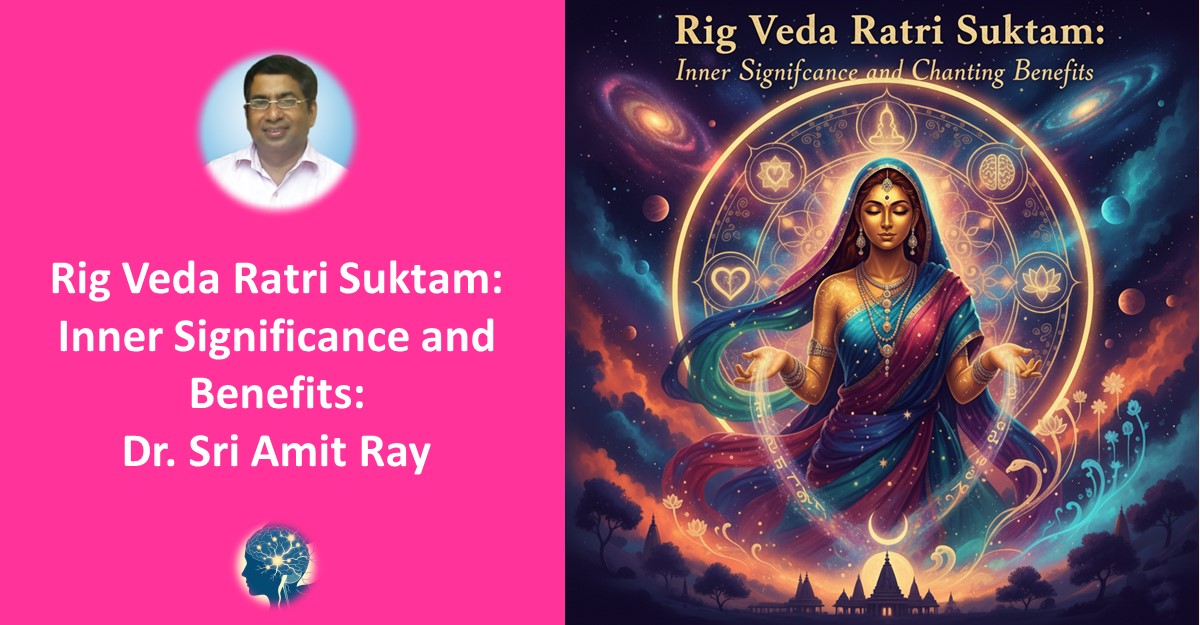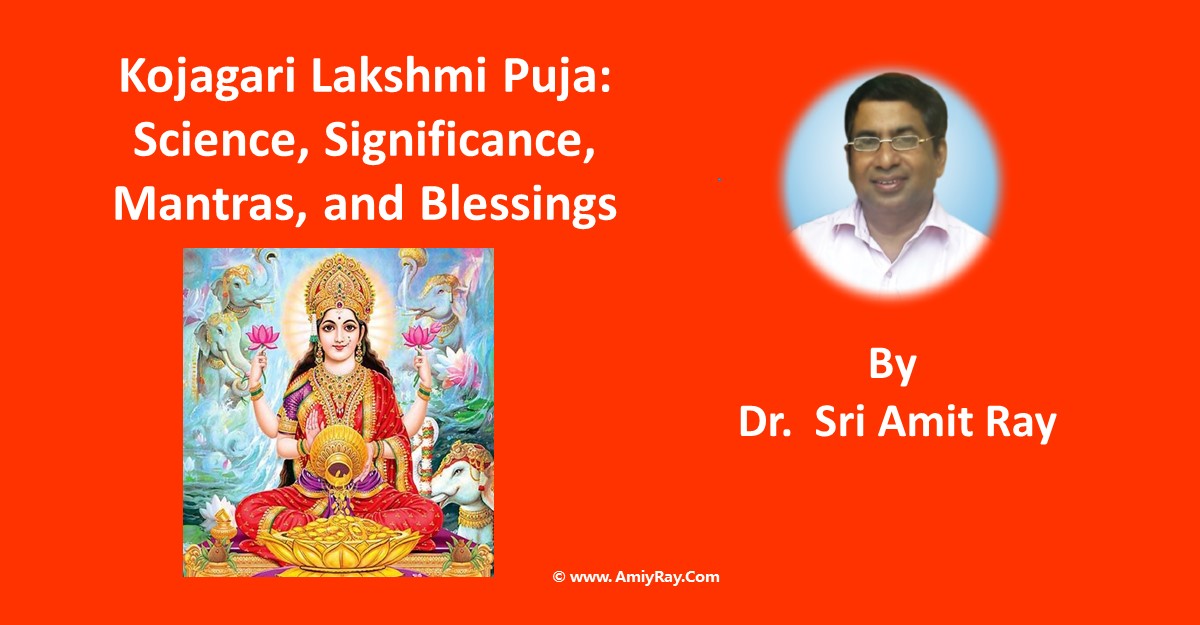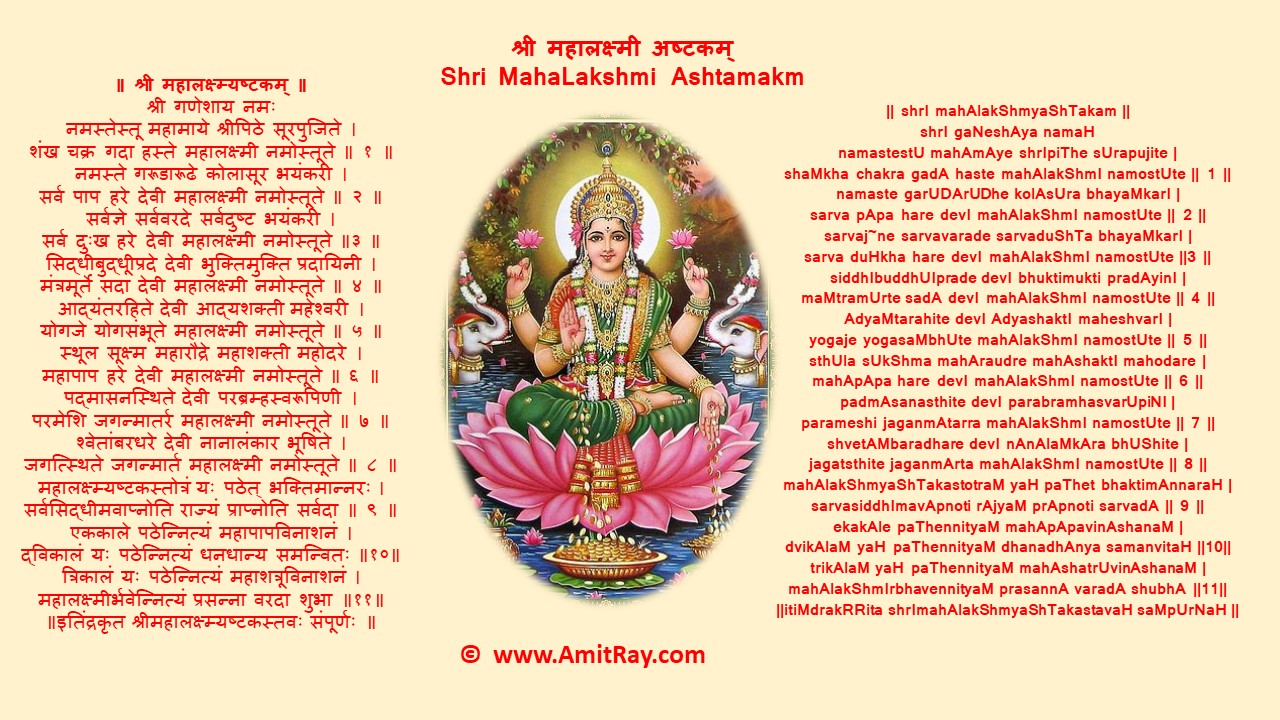The Ratri Sukta (Ratri Suktam) of the Rig Veda (10.127.1-8) is one of the most exquisite and contemplative hymns in the ancient Vedic canon. It is dedicated to Rātri Devī — the divine personification of Night. Night is considered as the womb of creation and manifestation. In spiritual tradition night is the time to conquer all types of fears. It is the fertile stillness from which new light arises. In this sense, Rātri is the mother of a new dawn.
Composed by the seer, Rishi Kushika, this hymn elevates the ordinary phenomenon of night into a symbol of cosmic protection, mystic beauty, and the cyclic rhythm of the universe. Far from depicting darkness as mere absence of light, the Ratri Sukta celebrates it as a sacred presence — soothing, sheltering, and deeply maternal.

In the Rig Veda, Uṣha (the radiant Dawn) and Ratri (the serene Night) are described as two divine sisters who follow one another eternally across the heavens. The Vedic seers saw in their cyclical dance the eternal rhythm of night — the cosmic order that sustains all existence. Neither overcomes the other; each gives birth to the other.
Rātri retreats, and Uṣā arises; Uṣā fades, and Rātri returns. They are the alternating breaths of the cosmos — the in-breath of repose and the out-breath of awakening. Both, Usha suktam and Ratri Suktam are linked to the Ray 114 chakras.
Here is an in-depth exploration of the ancient Vedic hymn dedicated to Ratri Devi, the divine embodiment of night.
https://www.youtube.com/watch?v=_cXJtKFCIB4
What is Ratri Sukta? | Origin | The Slokas | IAST Transliteration | Literal Meaning of the Shlokas | Spiritual Meanings | Significance | The 16 Moon Chakras| Night Chakras | Benefits | Rituals | FAQ
What is Ratri Sukta?
The Ratri Sukta, also known as the Hymn to the Night, is a revered Vedic hymn from the Rig Veda, one of the oldest sacred texts of Hinduism. Comprising eight verses, it personifies the night (Ratri) as a benevolent goddess who envelops the world in protective darkness, granting rest, peace, and renewal. Ratri Devi is depicted not as a fearsome entity but as a nurturing motherly force that wards off evil, harmonizes the cosmos, and prepares the dawn. This sukta celebrates the cyclical balance of day and night, symbolizing the eternal rhythm of creation, preservation, and dissolution. It is chanted to invoke divine protection and to attune the mind to the subtle energies of the universe.
Usha, Ratri, and the Sixteen Moon Chakras of the Sri Amit Ray Tradition
In the Sri Amit Ray tradition of the Sixteen Moon Chakras (Śoḍaśa Candra Chakras), the divine sisters Uṣā and Rātri are not only cosmic archetypes of dawn and night, but also subtle inner forces that regulate the lunar consciousness within the human being. These sixteen moon centers, extending from the crown of the head to the heart and base regions, govern the psychic tides of emotion, intuition, rest, and illumination. They mirror the sixteen lunar phases of the moon—each chakra a petal of cooling radiance that harmonizes mental light and shadow.
Uṣā corresponds to the ascending lunar dawn currents—those phases of consciousness where awareness brightens, creativity blossoms, and the inner mind begins to open toward higher perception. She awakens the upper moon chakras—especially those near the crown and brow—bringing clarity, optimism, and renewal after the night of stillness. Rātri, on the other hand, governs the descending lunar night currents, the gentle inward pull that cools, restores, and integrates experience within the lower and middle moon chakras. Her energy soothes emotional turbulence, deepens rest, and returns the mind to equilibrium.
Together, Uṣā and Rātri form the yin–yang of lunar awareness: illumination and repose, radiance and depth, reflection and regeneration. When the sixteen moon chakras are balanced through meditation and mantra, these twin goddesses merge within the heart and crown as a single field of soma–cit–śakti—the nectarous consciousness that transcends duality. In this inner union, the seeker experiences the sacred rhythm of cosmic breath: the eternal alternation of divine night and dawn within one’s own awareness.
This integration of Uṣā and Rātri within the 16 Moon Chakras refines the practitioner’s emotional and mental stability, enhances lunar hormonal harmony, and awakens the serene bliss of amṛta–bindu—the subtle moon drop of enlightenment that nourishes every cell and thought with peace. Thus, the Vedic rhythm of night and dawn finds its living reflection in the yogic anatomy of consciousness, revealing that the entire cosmos pulsates within the luminous heart of the meditator.
Soma, Bindu, Indu, Usha, and Ratri (Melatonin) Chakras
In the Sri Amit Ray Moon Chakra system, the Soma Chakra, Bindu Chakra, and Indu Chakra form the sacred triad of the higher lunar centers that regulate the inner flow of amṛta—the nectar of tranquility, rejuvenation, and subtle awareness. The Soma Chakra, located near the crown, radiates cooling vitality and serene bliss, sustaining emotional balance and neuro-hormonal harmony. Just below it, the Bindu Chakra serves as the subtle seed-point where consciousness condenses into the pure essence of stillness, guiding the descent of divine nectar through the subtle channels of the brain and spine. The Indu Chakra, placed near the upper occipital region, bridges the intuitive higher mind and the reflective dream states, refining both perception and mental luminosity.
The Uṣha Chakra, corresponding to the luminous frontal field, symbolizes the awakening of the inner dawn—a soft radiance of intuition, creativity, and inspiration that gently illumines the meditative mind. In complement, the Rātri Chakra—the melatonin or nocturnal consciousness center—is associated with the pineal complex and the neurochemical regulation of rest, circadian balance, and spiritual withdrawal into silence. When these five moon chakras are harmonized through rhythmic breathing and mantra resonance, the flows of soma, serotonin, and melatonin within the subtle neuro-endocrine system become balanced, inducing deep peace and lucid awareness.
In the unity of these centers, the seeker experiences the continuum of night and dawn within the yogic brain—a living cycle where sleep, intuition, and transcendence merge into one luminous stillness. This synthesis of Uṣā–Rātri consciousness within the Soma, Bindu, and Indu fields marks the inner alchemy of transformation, where the ordinary rhythms of the mind become the celestial pulsations of divine awareness.
The Context of the Hymn
In the Vedic worldview, every aspect of nature is infused with consciousness (chit) and divinity (devi). The dawn (Uṣas) and the night (Rātri) are twin goddesses who continuously chase one another across the heavens — symbolizing the eternal play of light and darkness, waking and resting, life and death.
The Ratri Suktam complements the hymns to Uṣas. While the dawn brings awakening and clarity, Rātri brings rest, introspection, and renewal. Together, they represent the balanced rhythm of existence — ṛta, the cosmic order.
Symbolism and Meaning
1. Rātri as the Cosmic Womb
Night in the Vedic imagination is not mere shadow but the yoni, the womb of creation. It is the fertile stillness from which new light arises. In this sense, Rātri is the mother of dawn. Out of her calm, luminous womb, Uṣas — the dawn — is born.
2. The Goddess of Rest and Renewal
The hymn praises Rātri as the one who “makes all beings rest” and “ushers peace into the heart of every home.” Night becomes the great equalizer — silencing distinctions and restoring harmony. Sleep, her gift, is the healing nectar that replenishes life’s fire.
3. The Guardian of Boundaries
Rātri is invoked to “cast away thieves and wolves,” to “hold back the wicked,” and to “grant safe passage through the night.” These are not only physical protections but metaphors for spiritual safeguarding — protecting the soul from inner turmoil, fear, and ignorance.
4. Night as the Path of the Mystic
For the spiritual seeker, night represents the inward journey — the descent into stillness where the outer senses rest and the inner light awakens. The Ratri Suktam thus anticipates the yogic idea of pratyāhāra — the withdrawal of the senses — leading toward meditation and realization.
Rātri and Uṣas: The Eternal Cycle
The twin hymns to Rātri and Uṣas mirror the principle of ṛta — the rhythmic alternation that sustains life. Rātri’s withdrawal naturally gives birth to Uṣas, and Uṣas’ radiance inevitably yields to Rātri. Neither dominates; both sustain the order of the cosmos.
Philosophical Dimensions
The Ratri Suktam offers profound metaphysical insight. Darkness, often feared, is reimagined as divine consciousness itself — the unmanifest (avyakta), the source of all form and light. In later Vedāntic and Tantric traditions, this becomes the Mahā-Rātri — the Great Night of Śiva, where all forms dissolve into pure being.
Origin
The Ratri Sukta originates from the Rig Veda, the foundational scripture of Vedic literature, composed around 1500–1200 BCE in ancient India. It is found in the 10th Mandala (book), Sukta 127, attributed to the rishi (sage) Kushika Saubhara, also known as Ratri Bharadwaja. The hymn is part of the later sections of the Rig Veda, reflecting profound philosophical insights into nature's forces. Vedic sages, through deep meditation and penance, "downloaded" this knowledge from the cosmic ether (Akasha), perceiving it as vibrational sound codes (shruti). Organized by Vyasa, the Vedas preserve such hymns as oral traditions emphasizing recitation for transmission. The sukta's themes echo the Vedic worldview of deifying natural phenomena, portraying Ratri as a sister to Ushas (Dawn), highlighting cosmic interdependence.
The Slokas
Below are the original Sanskrit slokas of the Ratri Sukta in Devanagari script.
Each verse is a rich mantra invoking the goddess.
रात्रिर्व्यख्यद्यदायती पुरुत्र देव्याक्षभिः । विश्वा अधि श्रियोऽधित ॥१॥
अर्वप्रा अमर्त्या निवतो देव्यूद्वतः । ज्योतिषा बाधते तमः ॥२॥
निरुस्स्वसा आरमस्कृतोषसं देव्यायतिं । अपेदु हासते तमः ॥३॥
सा नो अद्य यस्यावयं नि ते यामं न विक्ष्महि । वृक्षेण वासतिं वयः ॥४॥
नि ग्रामासो अविक्षत निपद्वन्तो नि पक्षिणः । नि श्येनास श्चिदर्थिनः ॥५॥
यवया वृक्या अम्र्वकं यवयस तेनमूर्मये । अथा नः सुतरा भवा ॥६॥
उप म पिपिशत्तमः कृष्णं व्यक्तमस्थित । उष रिणेव यातये ॥७॥
उप ते गा इवाकरं वृणीष्व दुहितर्दिवः । रात्रिः स्तोमं न जिग्युषे ॥८॥
IAST Transliteration
The International Alphabet of Sanskrit Transliteration (IAST) provides a Romanized version for easier pronunciation and study.
rātrir vyakhyad ayatī purutra devyākṣabhiḥ | viśvā adhi śriyo'dhita ||1||
arvaprā amartyā nivato devyūdvataḥ | jyotiṣā bādhate tamaḥ ||2||
nirussvasā āramaskṛtoṣasaṃ devyāyatīṃ | apedu hāsate tamaḥ ||3||
sā no adya yasyāvayaṃ ni te yāmaṃ na vikṣmahi | vṛkṣeṇa vāsatiṃ vayaḥ ||4||
ni grāmāso avikṣata nipadvanto ni pakṣiṇaḥ | ni śyenāsaś cidarthinaḥ ||5||
yavayā vṛkyā amṛvakaṃ yavayas tenamūrmaye | athā naḥ sutarā bhavā ||6||
upa ma pipiśattamaḥ kṛṣṇaṃ vyaktamasthita | uṣaṛṇeva yātaye ||7||
upa te gā ivākaraṃ vṛṇīṣva duhitardivaḥ | rātriḥ stomaṃ na jigyuṣe ||8||
Literal Meaning of the Shlokas
Here, each verse is broken down word-by-word for a direct, literal translation, revealing the hymn's poetic structure.
Verse 1
- rātriḥ = night
- vyakhyat = well-known
- āyatī = approaching
- puru-tra = in several places
- devyā = by the goddess
- akṣabhiḥ = with eyes (stars)
- viśvāḥ = all
- adhi = over/inherent
- śriyaḥ = wealth/glory
- adhita = adorned
The well-known Night approaches in many places with the eyes of the goddess; she adorns all inherent glories.
Verse 2
- arva-prā = pervading the expanse
- a-martyāḥ = immortals
- ni-vataḥ = those dwelling below
- devyū = of the goddess
- ud-vataḥ = those dwelling above
- jyotiṣā = with light
- bādhate = drives away
- tamaḥ = darkness/ignorance
She pervades the wide earth, immortals below and above of the goddess; with her light, she drives away the darkness.
Verse 3
- niḥ = for
- su-svasāram = dear sister
- ā = prepared
- ra-ma = path
- a-kṛta = made
- uṣasam = dawn
- devyā = of the goddess
- āyatīm = approaching
- apa = away
- idu = this
- hāsate = laughs at
- tamaḥ = ignorance
For her dear sister, she prepared the path for approaching dawn; she laughs away this ignorance.
Verse 4
- sā = she
- naḥ = to us
- adya = today
- yasyā = whose
- avayam = protection
- ni te = in you
- yāmaṃ = watch
- na = not
- vikṣmahi = fear
- vṛkṣeṇa = like in trees
- vāsatim = dwelling
- vayaḥ = birds
She comes to us today; in whose protection we do not fear the night, like birds dwelling in trees.
Verse 5
- ni = homeward
- grāmāsaḥ = villagers
- a-vikṣata = go unmolested
- ni-pad-vantaḥ = footed ones
- ni = homeward
- pakṣiṇaḥ = winged ones
- ni = homeward
- śyenāsaḥ = hawks
- ścit = even
- arthinaḥ = needy
Villagers, footed creatures, winged ones, even needy hawks go home unmolested.
Verse 6
- yāvayā = ward off
- vṛkyā = she-wolf
- a-mṛvakaṃ = thief
- yāvayas = ward off
- tenam = these
- ūrmaye = O wave (of night)
- athā = thus
- naḥ = for us
- sutarā = excellent
- bhavā = be
Ward off the she-wolf, the thief; O wave of night, thus be our excellent protector.
Verse 7
- upa = near
- ma = me
- pipiśat = devouring
- tamaḥ = darkness
- kṛṣṇaṃ = black
- vyaktam = manifest
- asthita = established
- uṣaḥ = dawn
- ṛṇe = debt
- iva = like
- yātaye = drive away
Draw near to me, drive away the devouring black darkness like dawn repays a debt.
Verse 8
- upa = to
- te = you
- gāḥ = cows (or rays)
- iva = like
- ākaraṃ = prepared
- vṛṇīṣva = accept
- duhitar = O daughter
- divaḥ = of heaven
- rātriḥ = O night
- stomaṃ = praise
- na = not
- jigyuṣe = desiring
To you, O daughter of heaven, accept these prepared praises like cows; O night, not desiring more.
Chanting Benefits and Inner Effects of the Ratri Suktam
1. The Sacred Power of Sound (Śabda Brahman)
In the Vedic tradition, sound is living consciousness. When the Ratri Suktam is chanted with devotion and awareness, each syllable awakens subtle forces in the mind and body. The rhythmic recitation aligns the mind with the cosmic rhythm of ṛta, invoking peace and balance.
2. Mental Effects: Calming, Centering, and Restorative
The gentle sounds of the hymn slow the breath and soothe the mind. Regular chanting reduces anxiety, purifies thoughts, and encourages meditative awareness. It promotes nidra śuddhi — purified, healing sleep — and releases the grip of overthinking.
3. Emotional Effects: Healing and Peace
The imagery of divine protection and serenity harmonizes the emotional body. Chanting helps release suppressed emotions, heal fear, and restore trust. The darkness becomes luminous calm — a space of inner comfort.
4. Spiritual Effects: Awakening the Inner Night and Inner Light
Spiritually, chanting the hymn guides the seeker inward — toward Mahā-Rātri, the Great Night of Consciousness. It cultivates śānti (peace), ātma-śaraṇāgati (surrender), and antar-prakāśa (inner illumination). The mantra resonates through the heart and brow chakras, balancing emotional depth with intuitive insight.
5. Healing Through the Night Goddess
Rātri Devī harmonizes the Idā (lunar) energy, calming the nervous system and restoring inner balance. Chanting supports restful sleep, mental clarity, and subtle healing by activating the parasympathetic response. It helps transform rest into meditation.
6. Practical Chanting Guidance
- Time: Chant at twilight (sandhyā) or before sleep.
- Posture: Sit comfortably with an erect spine and steady breath.
- Awareness: Feel the vibration in the heart and between the brows.
- Repetition: Chant softly and steadily, allowing silence after each verse.
- Intention: Offer the chant as surrender, invoking protection and renewal.
7. The Inner Revelation of Rātri
Ultimately, Rātri reveals herself as the silent consciousness behind all perception. The devotee realizes that darkness is not the absence of light but the infinite womb from which light is born. In this understanding, the night becomes the face of liberation.
Spiritual Meanings
The Ratri Sukta transcends literal nature worship, delving into profound spiritual symbolism. Ratri represents the infinite void of pure consciousness (Brahman), the formless Akasha that sustains the universe's vibration. Her "eyes" (stars) symbolize divine omniscience illuminating ignorance (tamas). As sister to Ushas, she embodies the tamas-rajas cycle, teaching transcendence of duality. Spiritually, invoking Ratri dissolves ego-bound fears, fostering surrender to the divine mother, leading to self-realization. She rescues from animalistic residues (greed, lust), reminding souls of their godly origin in cosmic darkness—the womb of creation. Chanting aligns one with Kala (time), obstructing inner darkness and awakening inner light.
Verse-wise Spiritual Insights
- Verse 1: Night's approach adorns cosmic glory, signifying how divine consciousness pervades all, making the infinite accessible.
- Verse 2: Pervading all realms, she illuminates ignorance, representing Akasha as the universe's sustaining vibration.
- Verse 3: Preparing dawn's path, she mocks sensory illusions, urging shift from fear to conscious awareness.
- Verse 4: Security in her embrace mirrors fetal oneness with the mother, symbolizing union with supreme consciousness.
- Verse 5: All beings return to origin in darkness, affirming evolution back to divine unity.
- Verse 6: Warding off wolves/thieves invokes protection from primal instincts, calling her the ultimate rescuer.
- Verse 7: Driving away inner darkness like dawn clears debts, echoing devotion to Kali for enlightenment.
- Verse 8: Offering praises humbly acknowledges her boundless grace, beyond human desire.
Significance
The Ratri Sukta holds immense significance in Vedic and Hindu traditions as a celebration of cosmic order (Rta). It underscores night's role in renewal, contrasting chaotic darkness with protective benevolence, thus balancing solar (day) and lunar (night) energies. Integrated into the Devi Mahatmyam, it honors the Divine Feminine (Shakti) as Ratri Devi, precursor to later forms like Kali. Philosophically, it teaches impermanence, interdependence, and transcendence of fear, influencing Upanishadic non-dualism. In rituals, it fosters harmony with natural cycles, promoting ecological and spiritual awareness. Its recitation during transitions (dusk to night) symbolizes life's passages, invoking peace amid uncertainty.
Benefits
Chanting the Ratri Sukta yields multifaceted benefits, blending physical, mental, and spiritual dimensions:
- Protection: Wards off negative energies, fears, and evil influences, providing a shield like night's enveloping calm.
- Mental Peace: Calms the agitated mind, reducing anxiety and promoting deeper, restorative sleep by balancing tamas.
- Spiritual Awakening: Dissolves ignorance, enhances intuition, and accelerates self-realization by connecting to cosmic consciousness.
- Energy Balance: Harmonizes bodily energies, alleviating sleep disorders and boosting vitality.
- Prosperity and Harmony: Invokes blessings for wealth, virtuous progeny, and fame, aligning with cosmic rhythms for success.
- Emotional Healing: Removes inner "thieves" like greed and envy, fostering contentment and fearlessness.
Rituals
The Ratri Sukta is ideally chanted during evening twilight (Sandhya) or before bedtime to align with night's energy. Key rituals include:
- Preparation: Bathe, wear clean clothes, face east or north, and sit comfortably with a lit lamp or incense.
- Invocation: Begin with Om and a sankalpa (intention) for protection or peace.
- Chanting: Recite the eight verses 3, 9, or 108 times, preferably with a guru or recording for correct pronunciation. Use a mala for counting.
- Offerings: Offer milk, flowers, or fruits to Ratri Devi's image; visualize her starry form.
- Integration: Part of Navratri or Devi Mahatmyam path; follow with meditation on darkness as divine womb.
- Closure: End with pranayama and thanks, sleeping with positive affirmations.
For enhanced efficacy, chant during Amavasya (new moon) or full moon nights.
FAQ
- What is the difference between Rig Veda Ratri Sukta and Tantrokta Ratri Sukta?
- The Rig Veda version is an ancient hymn to Night as a natural force; the Tantrokta is a tantric hymn from Devi Mahatmyam praising Durga's cosmic power.
- Can beginners chant Ratri Sukta?
- Yes, but learn proper pronunciation from a teacher to harness vibrational benefits; start with 3 recitations daily.
- Is Ratri Sukta only for nighttime?
- Primarily evening, but anytime for invoking protection; its themes apply to life's "dark" phases.
- Does chanting cure insomnia?
- It promotes relaxation and energy balance, aiding sleep, but consult a doctor for medical issues.
- What if I can't read Sanskrit?
- Use IAST or audio guides; focus on meaning and devotion for spiritual efficacy.
- Is there a specific deity to visualize?
- Visualize Ratri as a dark, starry mother embracing the world, or as Kali for deeper tantric layers.
Conclusion
The Rig Veda Ratri Suktam is one of humanity’s earliest hymns to the sacred feminine. It reminds us that peace and illumination arise from embracing stillness. In honoring the night, we honor the source — the eternal silence from which creation itself awakens.




